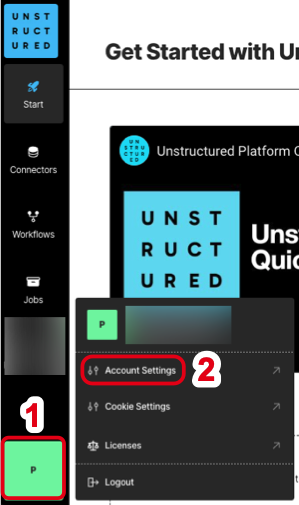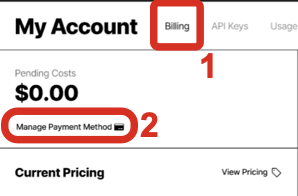Get started
To call the Unstructured Partition Endpoint, you need an Unstructured account and an Unstructured API key:If you signed up for Unstructured through the For Enterprise page, or if you are using a self-hosted deployment of Unstructured, the following information
about signing up, signing in, and getting your Unstructured API key might apply differently to you. For details, contact Unstructured Sales at sales@unstructured.io.
- Go to https://platform.unstructured.io and use your email address, Google account, or GitHub account to sign up for an Unstructured account (if you do not already have one) and sign into the account at the same time. The Unstructured user interface (UI) appears.
-
Get your Unstructured API key:
a. In the Unstructured UI, click API Keys on the sidebar.
b. Click Generate API Key.
c. Follow the on-screen instructions to finish generating the key.
d. Click the Copy icon next to your new key to add the key to your system’s clipboard. If you lose this key, simply return and click the Copy icon again.
By following the preceding instructions, you are signed up for a Developer pay per page account by default.To save money, consider switching to a Subscribe & Save account instead. To save even more money,
consider switching to an Enterprise account instead.
Set up billing
If you signed up for a pay-per-page plan, you can enjoy a free 14-day trial with usage capped at 1000 pages per day.If you initially signed up for a subscribe-and-save plan instead, of if you signed up through the For Enterprise page instead, your billing setup and terms will
be different. For billing guidance, contact Unstructured Sales at sales@unstructured.io.


- Sign in to your Unstructured account, at https://platform.unstructured.io.
- At the bottom of the sidebar, click your user icon, and then click Account Settings.
- Click the Billing tab.
- Click Manage Payment Method, follow the on-screen instructions to enter or update your payment details, and then click Save card.
You can save money by switching from a pay-per-page plan to a subscribe-and-save plan. To do this,
go to the Unstructured Subscribe & Save page and complete the on-screen instructions.
- For these file types, a page is a page, slide, or image: .pdf, .pptx, and .tiff.
- For .docx files that have page metadata, we calculate the number of pages based on that metadata.
- For all other file types, we calculate the number of pages as the file’s size divided by 100 KB.
- For non-file data, we calculate a page as 100 KB of incoming data to be processed.
Quickstart
This example uses the curl utility on your local machine to call the Unstructured Partition Endpoint. It sends a source (input) file from your local machine to the Unstructured Partition Endpoint which then delivers the processed data to a destination (output) location, also on your local machine. Data is processed on Unstructured-hosted compute resources. If you do not have a source file readily available, you could use for example a sample PDF file containing the text of the United States Constitution, available for download from https://constitutioncenter.org/media/files/constitution.pdf.1
Set environment variables
From your terminal or Command Prompt, set the following two environment variables.
- Replace
<your-unstructured-api-url>with the Unstructured Partition Endpoint URL, which ishttps://api.unstructuredapp.io/general/v0/general - Replace
<your-unstructured-api-key>with your Unstructured API key, which you generated earlier on this page.
2
Run the curl command
Run the following
curl command, replacing <path/to/file> with the path to the source file on your local machine.If the source file is not a PDF file, then remove ;type=application/pdf from the final --form option in this command.3
Examine the results
After you run the
curl command, the results are printed to your terminal or Command Prompt. The command might take several
minutes to complete.By default, the JSON is printed without indenting or other whitespace. You can pretty-print the JSON output by using utilities such as jq in future command runs.You can also pipe the JSON output to a local file by using the curl option -o, —output <file> in future command runs.Telemetry
We’ve partnered with Scarf to collect anonymized user statistics to understand which features our community is using and how to prioritize product decision-making in the future. To learn more about how we collect and use this data, please read our Privacy Policy. To opt out of this data collection, you can set the environment variableSCARF_NO_ANALYTICS=true before running any commands that call Unstructured hosted APIs.
